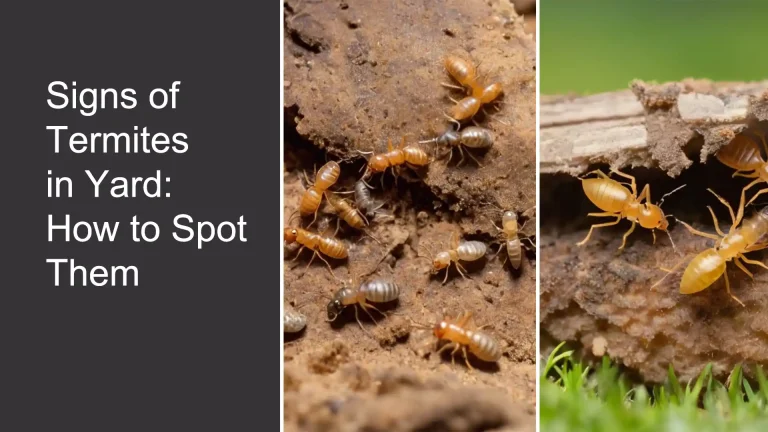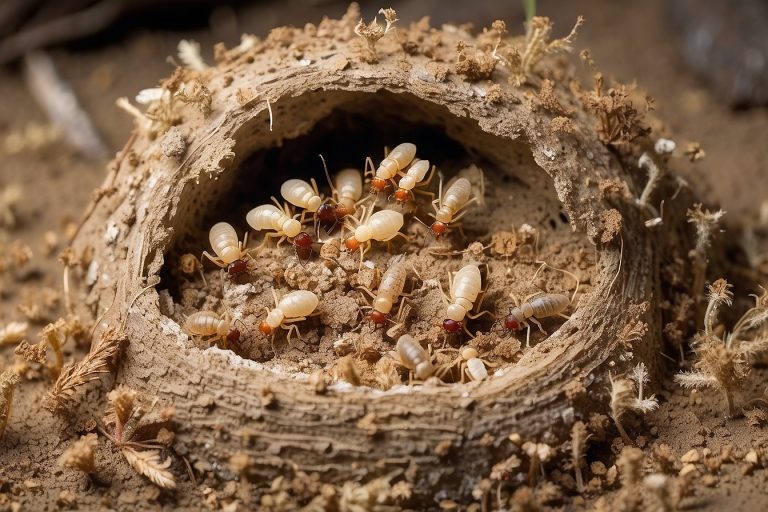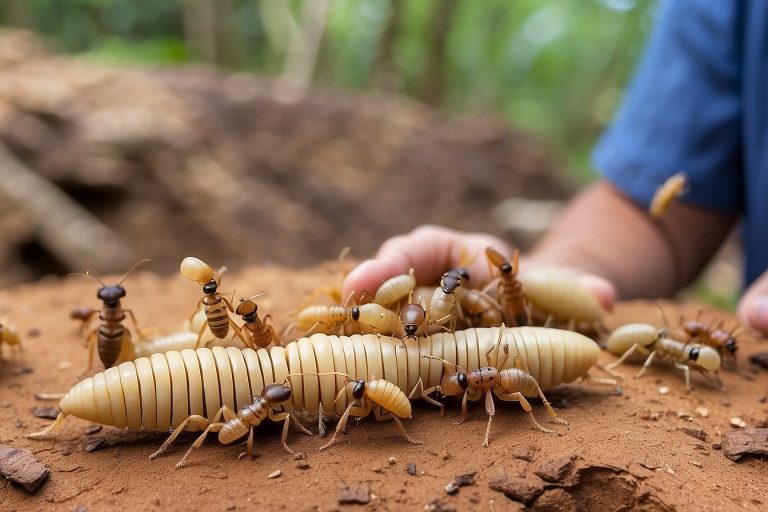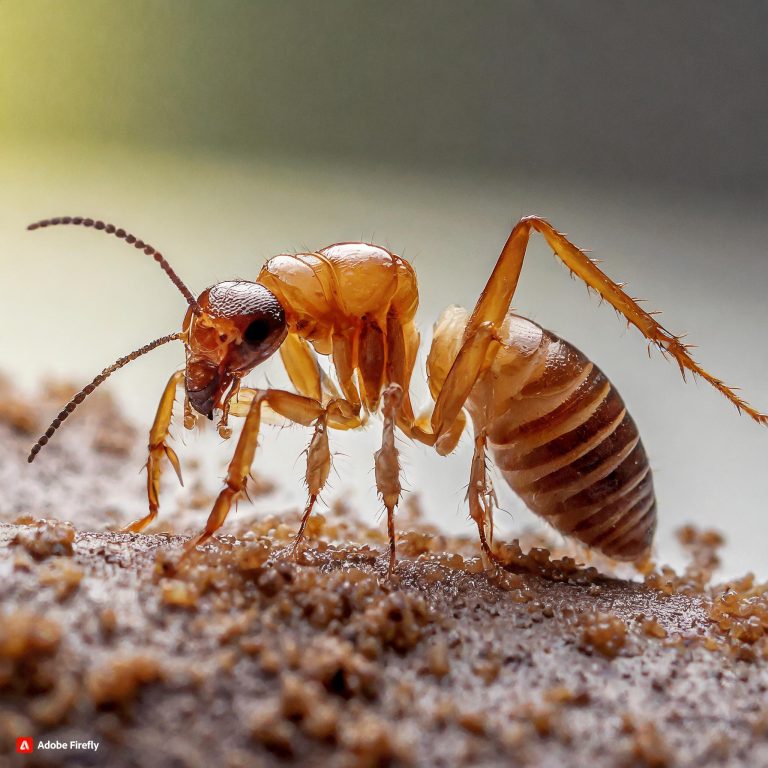What Do Termite Droppings Look Like? Identifying Termite Frass and Poop
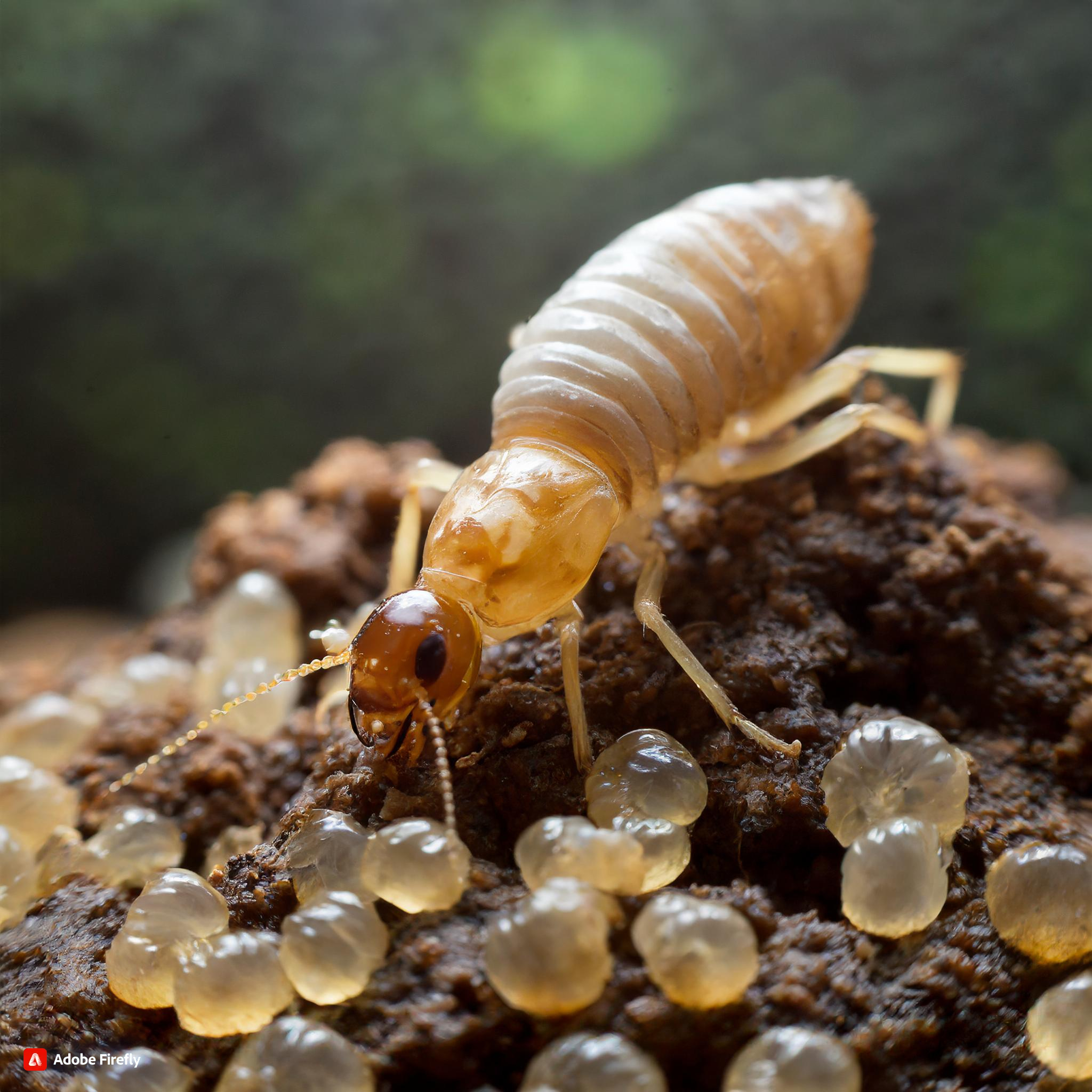
- What Do Termite Droppings Look Like?
- What is Termite Frass?
- Drywood Termite vs Subterranean Termite Droppings: Appearance and Size
- Signs of Termite Droppings and Frass
- How To Differentiate The Frass Of Different Termite Species
- Identifying Termite Droppings
- Where You Will Find Termite Droppings?
- How To Determine If Termite Droppings Are Old Or Fresh
- Common Places to Find Termite Droppings
- Getting Rid of Termites After Spotting Droppings
- Can Termite Droppings Be Dangerous?
- Health Risks of Termite Droppings
- Termite Damage Caused by Droppings
- Finding a Pest Control Professional
- Inspecting for Termites and Droppings
- Termite Treatment After Identifying Droppings
- Preventing Future Termite Infestations
- Termite Excrement or "Frass"
- Drywood Frass
- What Do Termite Pellets Look Like?
- Subterranean Frass
- Bullet Point Summary of Main Takeaways:
What Do Termite Droppings Look Like?
If you suspect a termite infestation in your home, one of the first signs you may notice is termite droppings, also known as frass. But what exactly do termite droppings look like? Keep reading to learn how to identify termite poop and frass so you can address an infestation ASAP.
What is Termite Frass?
Termite frass refers to the waste, excrement, or droppings left behind by termites. It consists of undigested wood and wood fibers. As termites feed on and damage wood materials in and around your home, they expel frass pellets.
So termite poop is essentially composed of their fecal matter combined with chewed up wood remnants. Seeing frass or droppings around your property means termites live inside and have active nests nearby. Their frass and mud tunnels serve as some of the most obvious termite signs.
Drywood Termite vs Subterranean Termite Droppings: Appearance and Size
Not all termite droppings look the same. Drywood termite frass tends to resemble piles of fine, sand-like sawdust or salt. Their fecal pellets measure around .5 to 1 mm wide. They build nests inside walls, frames, boards, and other wood structures.
Subterranean termite poop contains soil particles and appears more gritty and textured. Their droppings manifest as tiny, oblong-shaped pellets from 1 to 3 mm long. They nest underground and travel through mud tubes to reach wood sources above ground.
Dampwood termites produce larger and darker frass, around 3 mm wide. Regardless of species, termite poop generally looks like tiny granules, grains, or balls near damaged wood. Concentrated piles signal areas housing nests.
Signs of Termite Droppings and Frass
Active drywood termite droppings leave behind conspicuous signs of their presence. Here are the most common indicators that termites share your space:
- Granular fecal pellets that resemble coarse sand or powder
- Small mounds or piles of frass near wood sources
- Tiny holes in wood accompanied by salt-like debris
- Hollowed out cavities loaded with droppings
You may find drywood termite poop in wall voids, attics, sheds, under tile, between floor joints, inside furniture, and within wooden structures. The pellets cling together resembling sawdust that feels gritty when crushed.
Homeowners often locate drywood frass near:
- Baseboards
- Windows and door frames
- Ceilings and roof beams
- Sliding door tracks
Subterranean termites frequently deposit their droppings inside mud tubes as they travel between their underground nest and food supply. You can confirm their activity by breaking open random mud tubes to check for gritty frass inside.
Also examine areas with moisture issues closely for termite poop stuck in web-like mud structures. Signs of subterranean termites also include hollow wood damages and clay-like tubes extending towards houses.
How To Differentiate The Frass Of Different Termite Species
Since not all termite droppings look the same, their frass offers clues into what type has invaded your home. Here’s a quick comparison guide:
Drywood termites: Fine, sand-like debris and tiny kick-out holes
Subterranean termites: Gritty poop inside mud tubes
Dampwood termites: Large and dark-colored pellets
You can also gauge the severity of your infestation based on the sheer amount, accumulation, and location of the termite poop and holes you discover.
Identifying Termite Droppings
Wondering “what do termite droppings look like?” Here’s exactly how to spot termite poop and confirm if you have an infestation:
Size and Shape
Termite excrement consists of oval-shaped granules measuring anywhere from 0.5 mm to 3 mm long. Their width ranges between .5 mm to 1 mm.
Drywood termite poop aligns more with the smaller end of the spectrum. It may resemble coarse sand or salt particles.
On the other hand, dampwood and subterranean termite pellets better fit the average and larger size descriptions. Their droppings contain both wood and dirt particles, with subterranean frass tending to appear darker in color.
Texture
When examining potential termite droppings, consider their gritty, fibrous composition. Crush between your fingers – if they feel rough and fibrous, that points to termites as the culprit.
Subterranean termite poop in particular contains more soil particles, giving it a grittier, more textured feel. Drywood frass feels smoother but still grainy like sawdust.
Location
Concentrated piles indicate termite nesting zones. You’ll likely locate balls, tubes, or mounds of droppings:
- In wall voids and attics
- Under floor tiles
- Inside wood furniture
- Near plumbing fixtures and insulation
- Around exterior windows, doors, and roofing
Termite fecal matter expelled from their systems as they devour wood offers the best proof of an active infestation. Use frass color, size, pile volume, and location to determine what type has infiltrated your home.
Also look for telltale signs look like small piles of debris, the presence of live ants following termite trails, and holes in wood materials which indicate a serious termite problem requiring urgent inspection and treatment
Where You Will Find Termite Droppings?
Wondering where you can expect to encounter termite poop in your home? Here are the most common areas:
Drywood Termites
Look for drywood termite pellets:
- Behind picture frames and baseboard trim
- Under carpets near walls
- Inside drawers and cabinets
- Around wooden door and window components
Drywood termites nest inside of wood, so you’ll notice their droppings near infested lumber inside your home. Attics, sidings, wooden shakes, and fence posts also make prime real estate.
Subterranean Termites
Subterranean termites build expansive underground colonies and tunnel to food sources above ground. So their poop often concentrates:
- Inside mud tubes running along foundations
- Underneath moist bathroom and kitchen tiles
- Through concrete floor cracks
- Near plumbing leaks in walls or slab foundations
Also check damp firewood piles stored close to your home’s exterior. The moist conditions attract wide-ranging subterranean termite colonies.
Dampwood Termites
As their name suggests, dampwood termites thrive in humid environments with access to moisture-laden lumber. Scan areas like:
- Rotting roof beams
- Leaky window frames
- Standing water under sinks or tubs
- Hollow porch columns or posts
- Mildewy exterior siding and brick
Moisture access equates to prime dampwood termite habitat. So meticulously inspect wood materials exposed to humidity, flooding, condensation issues, or sprinkler damage.
By zeroing in on the likely hideouts and nesting sites of various termite species, you can pinpoint frass presence more quickly.
How To Determine If Termite Droppings Are Old Or Fresh
In addition to identification and location, the age of termite droppings provides useful intel. Follow these tips for determining new vs old frass:
- Old droppings appear dusty, dry, bleached, or weathered
- New frass looks clean, uniform, and bright white in color
- Compare debris piles – newly deposited poop sits atop older pellets
- Check for live termites – near fresh frass with moisture content
Recent termite activity requires swift intervention to halt spreading structural decays. So accurate aging sets the stage for appropriate control tactics targeting active nests.
Common Places to Find Termite Droppings
Do you suspect your home has termites but want to know precisely where to inspect for confirmation?
Start by scanning these common areas and materials for frass piles or stuck droppings:
- Attics
- Basements
- Crawl spaces
- Wood sidings
- Support beams
- Floor joists
- Window and door frames
- Sheetrock and insulation
- Furniture
- Books and papers
- Under carpets near walls
Indoors, concentrate on wood elements since different termite species directly damage lumber. Outdoors, peek inside fence posts, under stones or woodpiles, and around exterior structural components.
Termites venture from their nests into surrounding voids and cavities accessing usable food sources. So closet shelves, picture frames, and even cardboard boxes make potential debris trails you can follow back to the colony’s central nesting hub.
Meticulously checking all the nooks and crannies where termites may roam and poop greatly assists identifying hidden infestations sooner before extensive damages spread.
Getting Rid of Termites After Spotting Droppings
Locating termite droppings or frass inside your home confirms activity requiring professional intervention. Here are the next best steps:
1. Determine what type of termite species the frass came from – Identification sets the stage for tailored control methods based on nesting and feeding behaviors.
2. Contact a licensed pest control professional for inspection and treatment recommendations – DIY attempts often fail or make matters worse. Thermal heat, tent fumigation, soil treatments, and wood injections may get utilized.
3. Fix any moisture issues attracting termites – Fix leaky roofs, pipes, and seal exterior gaps depriving termites of needed water.
4. Schedule annual inspections – Termites persist as resilient pests requiring ongoing vigilance and preventative care. An ounce of prevention certainly applies!
Getting rid delivers short-term relief but preventative maintenance keeps infestations away for good. Let the droppings guide your remediation and protection efforts moving forward.
Can Termite Droppings Be Dangerous?
Termite droppings present little direct danger to human health. However, they still warrant extreme caution for a few reasons:
- Allergies – Microscopic particles may agitate respiratory issues when inhaled
- Asthma – Airborne frass proves problematic for asthmatics if stirred up
- Bacteria – Fecal pellets cultivate molds and microbes tied to illnesses
- Structural Damage – Invading termites seriously compromise building integrity over time
So while termite poop itself poses minimal risks, the underlying infestations and accumulating environmental contaminants precipitate a hazardous situation demanding quick response.
Health Risks of Termite Droppings
On their own, termite droppings contain mostly undigested wood fibers and particles. But the impacts of an underlying infestation do impact human health, namely:
Allergic reactions – Microscopic debris aggravates those sensitive to allergens
Asthma complications – Irritating particles suspended in air
Contaminated air quality – Gases emitted and mold growths cultivated
Antibiotic resistant bacteria breeds – Due to excessive moisture and decay
Compromised structures – Weakened foundations risk collapse and entrapment
Although rare, some fungal species triggering respiratory issues may accompany dormant colonies as well.
Prolonged exposures in confined spaces with poor ventilation allow concentrations of organic particulates to rise exponentially. Make sure to always wear protective equipment when cleaning or conducting work in infested areas.
Termite Damage Caused by Droppings
Beyond the physical damages resulting from termite feeding, their droppings lead to secondary decays over time:
- Short circuits & fires – Frass buildup inside walls and electronics
- Respiratory issues – Allergens and contaminants polluting indoor air
- Wood decays – Moist droppings cause dry rot fungal growth
- Weakened structures – Compromised stability due to extensive physical damages
Frass deposits block ventilation and retain moisture critical to fungal developments. As decay cascades through infested areas, overall integrity declines upping collapse hazards exponentially.
Always Uxport damaged debris properly to avoid circulations of filth throughout the home during cleanups. Bag refuse gently without rotations to mitigate spread.
Finding a Pest Control Professional
Discovering termite droppings means professional pest control intervention gets necessary ASAP. But finding the right exterminator matters just as much as taking quick action overall.
Here are tips for vetting reputable termite companies:
- Check credentials & licenses – Inspector & operator licenses should be current and applicable for your state.
- Request business references – Reputable companies gladly provide references upon request. Follow up with them.
- Seek referrals – Friends, family, neighbors prove useful resources. Repeat jobs reflect quality.
- Compare inspection reports – Get second opinions tying proposed solutions directly back to physical evidence found.
- Confirm insurance policies – General liability and damage coverage should meet state minimums.
- Ask about warranties & guarantees – Well-trained pros stand behind their work with written guarantees.
Professional affiliations like National Pest Management Association membership help confirm credibility as well. But don’t hesitate to ask lots of questions and verify everything before signing any contracts.
Inspecting for Termites and Droppings
To confirm or rule out termite activity, begin inspecting the interior and exterior of your home for shared signs:
Droppings – Check around wood-based materials for accumulated piles of granular debris or tube-shaped mud formations containing excrement.
Frass – Break apart the tubes to reveal wood fragments, soil particles, and fecal pellets inside pointing to termite presence.
Damage – Probe wood structures with a screwdriver for areas that feel exceptionally soft and damage easily under applied force.
Mud tunnels – Exterior foundation walls get checked for thick mud tubes extending towards wood elements on structures.
Also tap along baseboards, window frames, support posts and deck materials listening closely for hollow, uneven sounds indicating interior damages.
Keep a flashlight, gloves, small shovel, screwdriver, and protective respiratory gear on hand for easy access during inspection patrols. If evidence confirms termite activity, immediately reach out to pest control pros for intervention.
Termite Treatment After Identifying Droppings
Uncovering termite droppings or frass during inspections means contacting a licensed professional for treatment ASAP. Several methods exist for annihilating termite colonies and preventing new ones from appearing later.
Heat – Heating infested areas between 130 to 140°F kills termites present without using chemicals.
Cold – Cryonite or liquid nitrogen treatments flash freeze termites stopping their activity.
Fumigation – Sealing homes under tents floods the interior with lethal gasses penetrating walls voids with termites inside.
Chemical soil barrier – Creating a noxious perimeter around foundations repelling foraging worker termites from attempting to breach your home’s exterior again.
Wood injections – Filling lumber voids, frames and posts with long-lasting termiticidal products that leach toxins deadly to wood destroying insects.
Professional pest technicians determine best options based on severity, locations found, time of year, local building codes and other important factors during comprehensive site evaluations.
Preventing Future Termite Infestations
Avoiding repeat termite issues requires diligence across initial eradication and beyond as lifelong vigilance.
Remove moisture access – Fix plumbing leaks, better landscape drainage, utilize dehumidifiers to maintain indoor humidity under 45 percent.
Eliminate wood access – Create 18-24 inch gravel border separating soil from wood sidings. Clear dead trees and stumps from properties. Replace deteriorated exterior liners, frames and fixtures with molded vinyl materials termites cannot easily penetrate.
Conduct annual inspections – Reputable pest control companies offer preventative maintenance plans with regularly scheduled monitoring for both termites and common wood destroying insects continually attempting to breach homes.
Address new problems immediately – Never ignore signs of renewed termite activity, including frass present indoors. Swift response limits the scale of damage sites can expand otherwise.
Termite Excrement or “Frass”
In summary, termite frass refers to fecal droppings mixed with chewed wood fibers, soil sediment, undigested materials and waste particles. This combination floats throughout feeding zones and nest locations as glomerated piles, specks, and leftover traces stuck traversing wood surfaces and hidden voids.
Drywood Frass
Drywood termite poop contains primarily their fecal droppings combined with shredded local wood fibers used as food sources. It looks like fine coffee grounds or gritty powder scattered across attics, inside furniture, shelving, framing, and various structural wood elements.
What Do Termite Pellets Look Like?
Termite poop pellets appear as partially broken down wood fragments fused with loose soil bits and speckled waste remnants concentrated inside mud tunnels or as mounded granular piles around active feeding sites near wood materials showing visible damage upon closer inspections.
Subterranean Frass
Subterranean termite droppings seem especially gritty since their diets derive heavily from soils. Their frass loads into pre-dug underground tunnels meandering upwards from nests below before branching horizontally towards newly discovered food reservoirs detected by roving worker castes. Expect to find loose balls and oblong shaped fecal structures stuck along their muddy highways or scattered across basement slabs and shower floor tiles following heavy rainfalls flooding their networks briefly.
In closing, termite droppings offer the most obvious proof of live activity within structures although no visible pests may present themselves initially. Don’t ignore signs of infestation. Identify species and nest locations based on frass debris analysis. Then contact licensed professionals to implement solutions neutralizing threats posed by large invading colonies before irreparable loss and unsafe conditions take hold.
The bottom line remains that termite droppings should never get ignored or simply cleaned up without further defenses taken. Their persistent tunneling and feeding week after week inevitably compromises structural stability over time. Seeking immediate elimination solutions before further spread or secondary moisture damages occur makes the most prudent response.
Bullet Point Summary of Main Takeaways:
- Termite frass refers to fecal droppings expelled from their systems as termites digest surrounding wood materials
- Different types of termites including drywood, dampwood and subterranean all produce slightly different frass pellets
- Telltale signs of active infestations include piles, tubes and trails of granular debris near various wood elements inside homes
- Carefully match dropping size, shape, texture and locations where found back to known frass fingerprints of potential termite species
- Drywood droppings resemble fine sand or coffee grounds while subterranean poop contains more grit from tunneling through soils frequently
- Always contact pest control professionals for complete home inspections and implementing solutions to both eliminate and protect against future termite colonies attempting to invade
As you have now learned, termite frass provides the critical definitive evidence confirming live activity. While cleaning remains important limiting spread, true pest eradication requires professional treatments tailored to species and nest locations revealed through careful droppings analysis from attics to crawlspaces and everywhere in-between across infested structures.
So use what the termites leave behind against themselves! Catching invasions early before mass damages makes containment much more likely short of total fumigations. Know what to look for and respond appropriately as soon as those first tiny pellets get spotted!

